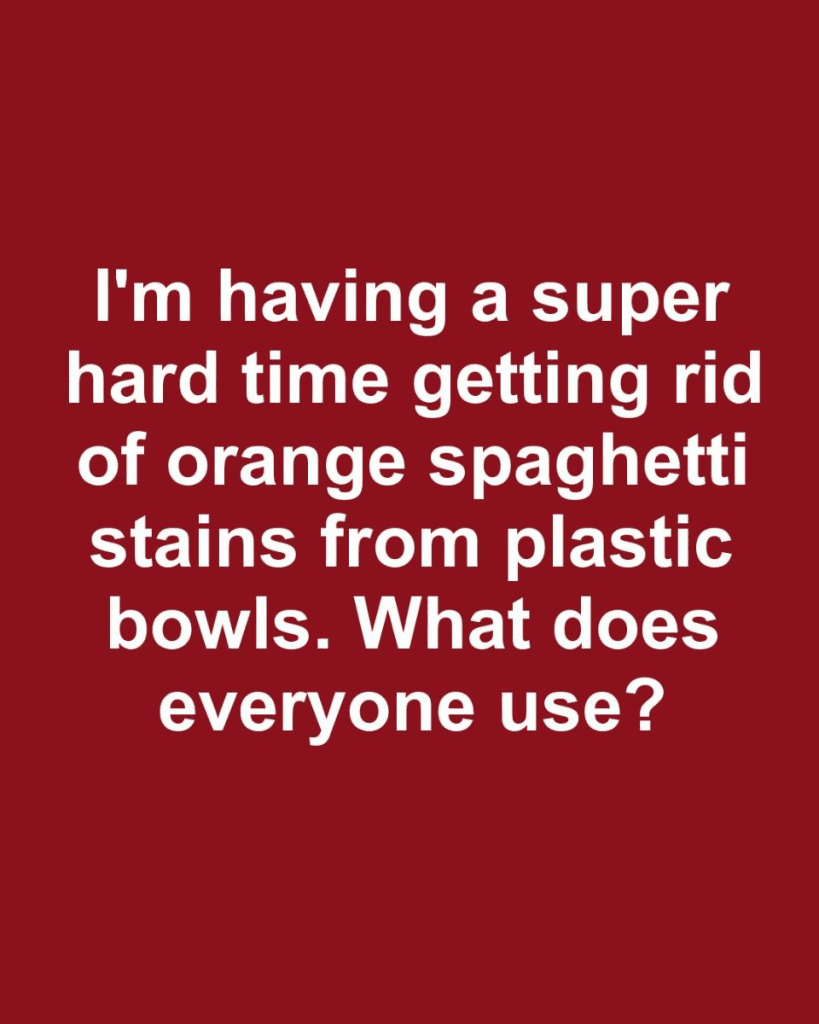Spaghetti with rich, flavorful tomato sauce is a staple in many households. But along with that delicious meal often comes a frustrating problem—those stubborn orange stains on plastic bowls. If you’ve ever struggled to scrub out spaghetti sauce stains, you’re not alone. The porous nature of plastic often holds onto pigments, especially those in tomato-based sauces, leaving behind a tint that seems impossible to remove. This guide dives deep into the science behind these stains, effective cleaning techniques, and the best ways to prevent them, so your plastic kitchenware stays spotless.

Why Plastic Bowls Stain So Easily
Plastic bowls are a go-to choice for many because of their durability and affordability. But the very properties that make plastic so practical also make it prone to staining. Most plastics, especially inexpensive ones, have tiny, nearly invisible pores or imperfections on their surfaces. These pores trap oils and pigments from food, causing stains. Tomato-based sauces, known for their vivid color and acidity, are particularly notorious for leaving lasting stains due to their unique chemical composition.
The Science of Tomato-Based Stains
Tomatoes contain a pigment called lycopene, a type of carotenoid that gives tomatoes their vibrant red color. Lycopene is lipid-soluble, meaning it binds well with fats and oils in sauces, making it extra clingy to plastic surfaces. The acidity in tomatoes further exacerbates the issue by causing plastic to swell slightly, allowing the pigment to penetrate deeper into the material. This combination of oil, pigmentation, and acidity creates the perfect storm for stubborn stains.
Pre-Treatment Tips for Stain Prevention
Acting quickly after enjoying your spaghetti can make a significant difference in preventing stains. Here are some effective pre-treatment techniques:
- Rinse Immediately with Cold Water: After you finish eating, rinse the bowl with cold water to wash away excess sauce. Avoid hot water, which can open up the plastic’s pores, allowing the pigments to set even deeper.
- Apply Baking Soda Paste: Baking soda is a natural stain remover. Mix it with a bit of water to form a paste, apply it to the stained areas, and let it sit for several hours or even overnight. This gentle, abrasive paste helps lift stains from the plastic.
- Use Vinegar Soaks: Soaking the bowl in vinegar can help break down residual oils and pigments. Simply fill the bowl with vinegar and let it sit for about 30 minutes before washing as usual.
Top Cleaning Agents and Detergents for Plastic
Sometimes, traditional dish soap just doesn’t cut it. For those deeply embedded spaghetti stains, certain cleaning agents and detergents can provide the extra cleaning power you need.
- Oxygen Bleach: Oxygen bleach is a non-toxic cleaner that’s safe for plastics and can effectively lift tough stains without damaging the material. Mix it with water according to package instructions, let the plastic bowl soak, and rinse thoroughly.
- Plastic-Safe Degreasers: Look for plastic-safe degreasers specifically designed for kitchenware. These degreasers target the oils in tomato sauces that cling to plastic, helping to break down stains.
- Household Bleach (Use Caution): If all else fails, a diluted bleach solution can be effective. However, it’s essential to use caution—rinse thoroughly to ensure no bleach residue remains, as it can be harmful if ingested.
Effective Household Remedies for Stubborn Stains
You likely have several effective stain-fighting ingredients right in your kitchen. These natural remedies can be surprisingly powerful against tomato-based stains on plastic.
- Lemon Juice: Lemon juice’s natural acidity helps lighten stains. Rub a slice of lemon over the stained area or apply lemon juice directly, letting it sit for a few hours. Rinse thoroughly and repeat if necessary.
- Vinegar and Baking Soda Mix: Combining vinegar and baking soda creates a mild abrasive paste that can lift stains. Sprinkle baking soda on the stain, add a few drops of vinegar, and scrub gently. This foaming reaction helps loosen particles trapped in the plastic.
- Sunlight Bleaching: Placing stained plastic bowls in direct sunlight can help naturally bleach out the color over time. Sunlight breaks down pigments, making it a great eco-friendly option for removing stains.
Innovative Cleaning Gadgets for Persistent Stains
If you’re willing to invest in a few specialized tools, there are innovative gadgets that can help tackle even the most stubborn stains in plasticware.
- Ultrasonic Cleaners: Typically used for cleaning jewelry, ultrasonic cleaners have recently become popular for small kitchen items. These devices use high-frequency sound waves to create tiny bubbles that lift dirt and stains, effectively removing particles embedded in the plastic.
- Steam Cleaners: Steam cleaners provide a chemical-free way to tackle stubborn stains. The high-temperature steam helps loosen pigments and oils, making it easier to wash away stains afterward.
- Magic Erasers: Specially designed for tough stains, Magic Erasers and similar micro-abrasive sponges work wonders on plastic surfaces. These sponges are made of melamine foam, which gently scrubs away surface stains without damaging the plastic.
Preventative Measures to Keep Plastic Stain-Free
As the saying goes, prevention is better than cure. A few proactive measures can help keep your plastic bowls free of unsightly stains.
- Apply a Light Oil Coating: Before serving tomato-based dishes, try applying a thin layer of oil to the plastic bowl. This coating can act as a barrier, preventing the sauce from bonding directly with the plastic.
- Switch to Glass or Ceramic for Stain-Prone Foods: If possible, use glass or ceramic containers for serving and storing tomato-based dishes. These materials are naturally resistant to staining and are easier to clean.
- Wipe Bowls Promptly After Use: Once you’ve finished your meal, try to wipe or rinse your plastic bowls as soon as possible to prevent the stain from setting.
- Store Tomato-Based Leftovers in Non-Plastic Containers: When storing leftovers, avoid plastic containers for tomato-heavy dishes. Glass containers are ideal for foods prone to staining, as they resist absorbing pigments and odors.
Environmental Considerations for Stain Removal Methods
While maintaining clean plastic bowls is essential, it’s also worth considering the environmental impact of your cleaning methods. Some commercial cleaners contain chemicals that can harm the environment if not disposed of properly. Here’s how you can make your stain removal process more eco-friendly:
- Opt for Biodegradable Cleaners: Look for eco-friendly, biodegradable cleaning agents that break down naturally and don’t harm the environment.
- Natural Remedies First: Using household items like vinegar, lemon juice, and baking soda not only reduces chemical exposure but also minimizes waste.
- Limit Water Waste: Avoid excessive soaking or rinsing by using concentrated cleaning techniques and efficient rinsing methods.
Balancing effectiveness with environmental responsibility ensures that your stain-removal process is both efficient and eco-conscious.
Choosing the Right Solution for Your Stain Situation
With so many methods to choose from, it’s essential to evaluate what works best for you. Each technique has its strengths and may be more or less effective depending on the type and severity of the stain. Here’s a quick rundown of what to consider:
- Stain Severity: Light stains may come off with a simple baking soda scrub, while deeper stains might require soaking or more potent agents.
- Time Available: If you’re short on time, a quick pre-treatment or using a degreaser may be ideal. For more stubborn stains, methods involving longer soaking times, like vinegar or sunlight exposure, could be better suited.
- Frequency of Use: For those who use plastic bowls regularly with stain-prone foods, preventative measures or investing in cleaning gadgets may offer a more sustainable long-term solution.
Exploring Community Tips and Advice for Spaghetti Stains
In addition to tried-and-true methods, learning from others’ experiences can provide creative solutions that you may not find in typical guides. From online forums to social media groups, there’s a wealth of community knowledge that can offer unique insights.
Some individuals have found unconventional tricks, like rubbing raw potato on stains or using denture cleaning tablets to break down stubborn marks. Experimenting with these community-tested hacks can sometimes lead to surprisingly effective results.
Engaging with other kitchen enthusiasts can help build a knowledge base of stain-fighting techniques, turning a frustrating problem into an opportunity for communal learning and support.
Conclusion: Maintaining a Stain-Free Kitchen with Ease
Removing spaghetti stains from plastic bowls might feel like an ongoing battle, but with the right approach, it’s entirely manageable. By understanding why stains happen, pre-treating promptly, using effective cleaning agents, and employing preventative measures, you can keep your plasticware looking fresh and stain-free. Whether you choose natural remedies, specialized cleaning products, or innovative gadgets, there’s a solution that fits every kitchen and lifestyle.
Armed with these methods, you’ll be ready to tackle even the toughest spaghetti stains, ensuring your favorite plastic bowls remain clean and ready for many more meals to come.


